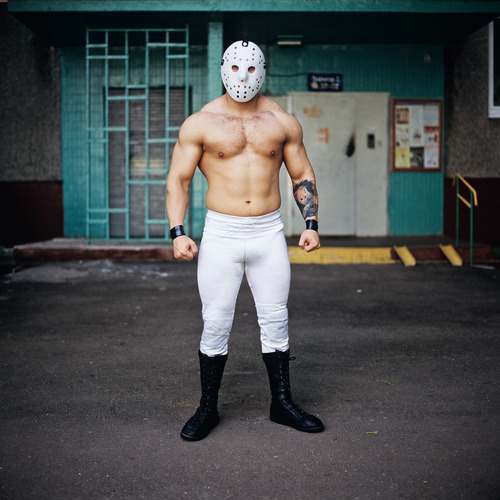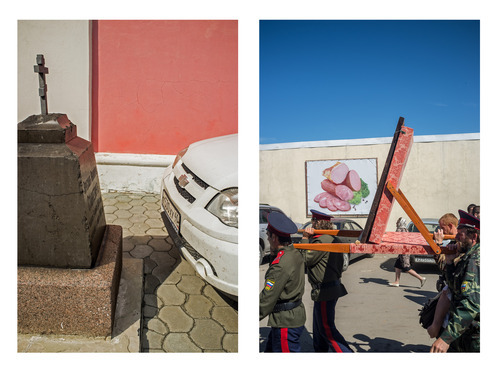Valeri, could you tell us about your art. Are you from the generation of documentary photographers which started shooting Russia in 90’s? I know that you were involved in war photography and visited ‘hot spots’. You covered the collapse of USSR for Western media, but mainly you work in Russian province. You mentioned once that you are able to shoot even ‘emptiness’. Who are you - visual anthropologist? Art photographer? Or documentary photographer who uses methods of art photography? Why did you decide to move towards deep photographic research, what influenced you?
Valeri Nistratov (VN): I don’t remember much from the first so called ‘news’ period of my career. I dimly remember this period. It was mostly related to my self-determination and a search of myself. At that time photography was a tool for search and experiment with oneself. I saw a lot of events, I photographed them, published photos. That was useful experience. This experience is less photographic but more adventurous. It is the most important thing I kept from the period of making the news photography, that lasted less than 3 years.

© Valeri Nistratov
Ideally, I wouldn’t like to be classified to any categories you mentioned. In my point of view, belonging to any category and defining borders restricts the territory of actions. But of course I understand that the author is the style. I wouldn’t define myself as a photojournalist nor art photographer. Probably, I am an Observer and partly a Researcher and my photographs are ‘lyrical’ or ‘poetical’ documents. It seems like I am somewhere in-between of documentary space and I am satisfied with it.
Who are your favourite photographers?
VN: Unfortunately (or fortunately) I have no favourite photographers nor writers or filmmakers. Everyone from my long list of ‘favourite’ influenced me, left something very deep and controversial in my consciousness and I am not sure if I understand now who was the most important. When I was young, my idols were Bresson and Capa. Bresson was a kind of ikon - we idolized him. It was hard to resist it. Capa wasn’t idolized, we just were envious of him and fascinated by him. Capa has been attracting me as a man who lived as he wanted and who’s life was full of adventures. Cold and a bit closed type of personality of Bresson and very open, practically Gipsy type of Capa. I perceive these two conditions like yin and yang and they are still in me. They supplement each other. But cinema, literature and painting still inspire me the most. I saw many times Dovzenko (Earth), New Wave Films (‘Breathless’ and ‘Pierrot the madman’ by Jean-Luc Godard), Seven Samurai, Rashomon and Ran by Kurosava, movies by Paradzanov, Tarkovsky, Wim Wenders and Alan Tanner. The list can be continued, but I think it is enough to mention these because they are, actually, the whole worlds and planets. And planets have orbits and satellites. That is astronomy in photography.

© Valeri Nistratov
I consider photography as a system of languages. For instance, the American kind of photographical language and its inflexions were always closer to me than the European. For me it is not related to a particular author nor a school, but with spirits, distance, light, color, form and ‘the magical space of realism’ that has been (or rather was) in American photography. Not without reason, one of my favourite artists was Edward Hopper. I share his feelings of surprise and loneliness, I think I feel something similar in Eurasian spaces.
I liked the idea of freedom and light in early works of Edward S. Curtis, a documentary style, a poetry of local and daily life of Walter Evans, subjectivity, melancholy and critical eye of Robert Frank as well as a calm and peaceful world in works of Robert Adams and Lewis Baltz. I suppose I am quite familiar with history of photography and of course I am aware of mutual influences in the Anglo-Saxon world. However American ideas did not overshadow, but rather awoken the interest to Russian and Eastern culture. An introduction to the world of Russian (at that time Soviet) photography began with a Soviet Photo magazine. There was a series ‘Opening of peasant resort in Livadia’ by Arkady Shaikhet. I was touched by the way the author expresses irony and absurdity. Then I saw Lithuanian photographers and Soviet non-conformists who are already well-known.

© Valeri Nistratov
Maxim Dmitriev and Sergey Prokudin-Gorsky - pioneers of pure documentary in Russia - are also fascinating me. Now one talks a lot (not without irony) about need of ‘special Russian gaze’ in photography. Of course, we should have topics which are relevant for us, because we live here, we have connection with this place - that’s normal thing. But, as everybody knows, you can only see the big picture from a distance. We need to become a bit foreign in order to see our own ‘Russianness’, uniqueness and peculiarity and reflect it in photography. Then, you’ll see a difference, but rather in a quality of your photographs, not in quantity of love to the homeland.
How did you end up teaching photography? Was it your purposeful decision or it just happened? What does teaching mean for you?
VN: It seems like I started teaching because of my desire to share my experience and to find like-minded persons among students who want to look at the reality in different way and to dedicate their life to photography. The main goal for me is to teach students to think visually and change their mind, not only to make them ‘professional photographers’ who work in the industry (which is also sometimes not that bad).

© ValerI Nistratov
One could be trained in all the things and majority of art schools in the world have been doing it very well, but it is impossible to teach how to develop your personality. Obsession with photography is impossible to teach either. But without it you can not be a good photographer. Sometimes young people with different mental problems come to the school. Probably, they believe that art can help them to fight with these problems. Of course the school is not psychological center, but we have to help them. We are all a bit psychotherapists and even spiritualists. I would insist on ortodoxal point of view - talent is something that you get from the nature. I believe in it.
You are the curator of the course ‘Documentary photography’. What is the most important for you when you look at portfolios of future students? What kind of persons do you choose? I guess it is very competitive and you have to select strictly!
VN: In our school there are preliminary tutorials where a curator can meet entrants and give them advices. Different young people come to these consultations (mostly in their twenty, sometimes in early thirty). I am not interested to take in my group people who work professionally in commercial photography, because their eye is already spoiled and it is very unlikely that they will think differently. Nonetheless there are some exceptions. More than a half of our students are women. A portrait of Russian girl who wants to become a photo-based artist remain mysterious to me.

© Данила Ткаченко, student work
Nevertheless I can say that they have more energy and obsession with art in comparison with boys. The most important qualities for me (when I select my future students) are charisma, taste to adventures, obsession with what they are doing, vitality and even sexuality - all other things could be learned during your study.
In one of your interviews you mentioned that your approach to photography is an intuitive one. Though while being a teacher you need to articulate a lot of things in order to teach someone (and it is the most common problem among artists, who used to work this way). ‘Technology of shooting has nothing to do with logic. A man gets information from outside and records it on paper, film or something else. In this regard a photoshoot starts from the feeling. You can not think about anything during your shooting. Ideally, you need to turn off your head’ (from your interview for photographer.ru). How do you manage to verbalize this feeling for students?
VN: Usually, I don’t even try to teach someone to feel what do I feel intuitively. It is something like teaching people to love. It’s impossible and even dangerous. Because of that I am not in a hurry to teach shooting process in my class. Usually, I narrate about my way of shooting (or someone’s else way) and let them know that they will surely work differently. I would like them to find their own way of doing things and don’t copy anyone although it is terribly hard in the epoch of postmodernity.

© Лилия Ли Ми Ян, student work
How is your course structured? Do you go to shoot outside of Moscow? Do you shoot street? Do your students work with texts? What kind of projects they work on?
VN: The school year is divided into 3 semesters. I propose to my students at the beginning of each semester to make a big project (usually it is an interpretation of a particular topic - for instance, ‘a balance’) and a couple of small tasks. At the end of the semesters we open student’s exhibitions in the school gallery. While working on the tasks we are discussing the stages of shooting. We meet once a week in a studio. These meetings begin from my lessons and finish by analysis of student’s works. Usually, our classes take the whole day long until the late evening. My main task is to deconstruct photographical structure of a particular shot and then to construct it again while explaining how could one use this later.

© Ксения Коржикова, student work
Students finish their study with a graduate work and take part in a collective exhibition in Multimedia Art Museum in Moscow. During our lectures we discuss very different topics ranging from contemporary photography to the current affairs in Russia and abroad. In our school there are a lot of lessons on contemporary art, history of photography and new media, so students work with texts a lot. On my lectures we discuss the most important texts on photography and work with texts written for projects and series, study how to write photographical proposals. I must admit that working with texts is the hardest work in my teaching experience, because our students don’t like to write texts at all.
I would like to touch on the theoretical aspect of your work. For example, there are a lot of links to the books of Soviet historian Lev Gumilev in your photo project ‘Forest-steppe’. You read a lot, you are interested in history of Russia and USSR and your photographs are, to some extent, results of this research. Do your students read a lot as well? Do you recommend them what to read?
VN: In my point of view, today people read books less and more click links to some texts in the Internet. But the interest to the classical texts such as books written by Benjamin, Flusser, Baudrillard, Sontag and Szarkowski is still high. It is a must read because they are included in the exams our students have to pass. I read aloud fragments of these texts during my lectures and we try to discuss them together.
Who are your famous students? What are their achievements?
VN: It is the hardest question for me, because if I name someone others could be disappointed. Nonetheless, I would say that all of my students are very promising. And being well-known fully depends on their actions. You are the master of your own business. Nevertheless, I would mention the most obsessed students such as Danila Tkachenko, Dmitry Lukjanov, Lilia Limi Jan, Ksenia Ivanova, Natalia Maximova, Anastasia Rudenko, Ksenia Galkina, Yulia Abzaltdinova.

© Дмитрий Лукьянов, student work
How does teaching change you? Do you look at your own work differently? Probably, it is not only you who influence the students, but they influence you also? What project are you currently working on?
VN: I comfort myself (sincerely and a bit naively) with the idea that teaching can improve my metabolism and cell renewal. It is very important for me to keep the unity of the process - Shooting - Editing - Teaching. In my case they all are connected together. The school is actually a kind of art laboratory and it is interesting for me. I have no illusions about getting something new for myself from young people - I am still young myself, in fact. Nevertheless, I happened to have more experience than they. In this sense, I look up to Stephen Shore and Minor White, who succeeded in combining teaching and doing their own art.

© ValerI Nistratov
This year I finished to work on several series. The first one called ‘Home’ and it is a part of my long-term project named ‘Russian Typologies’. The second one is a trilogy ‘Lost Horizon’ and I am currently editing it. In the near future I do not plan to work on big projects, rather I would like to focus on small essays and series.
---
LINKS
ValerI Nistratov
Rodchenko Art School
Russia
share this page